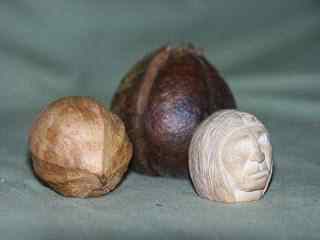Hickory – Special tree – Special nut
A great thing about our work is meeting so many great people and being exposed to their special interests. Years ago we met a man who enjoyed wood-carving. A favorite medium for him was the nuts of hickory trees. Through him we have learned more about hickory trees.
Did you know hickory trees once grow in Europe and have been around for centuries? However, today you will find this tree only in China, Mexico, and U.S. Actually there is one species of hickory in China and one in Mexico but something like 15 in U.S.
The three most commonly grown hickories in U.S. are the shellbark, or kingnut, the shagbark and Southern shagbark. The Southern shagbark grows primarily in the southeastern states in areas where large deposits of limestone are found, while the shagbark normally grows on dry ridges. The shellbark prefers rich moist bottomlands. Nuts of the Southern shagbark are smallest, and those of the shellbark the largest. (I think a shellbark nut was used in the pictured carving). All are encased in soft outer husks that split open at maturity revealing hard-shelled nuts with a sweet flavor.
Hickory trees such as the shellbark and shagbark are prized not only for their sweet-tasting nuts but for their wood as well. The durable wood is used extensively to manufacture handles for all types of tools including axes and hammers, and the smoke produced by burning the wood is useful to cook and cure meats. Better grades of hickory wood are also used to build furniture and in the manufacture of wall paneling. Not only are hickory nuts appealing to humans, but squirrels, ducks and turkeys enjoy them.



